




Want to sell more on Instagram without relying on ads? Wondering if organic Instagram content can attract and convert paying customers?
In this guide, you’ll find an 11-step process to create an organic Instagram marketing strategy from scratch. Plus, you’ll discover exactly how to put that strategy into practice and start selling without the ad spend.
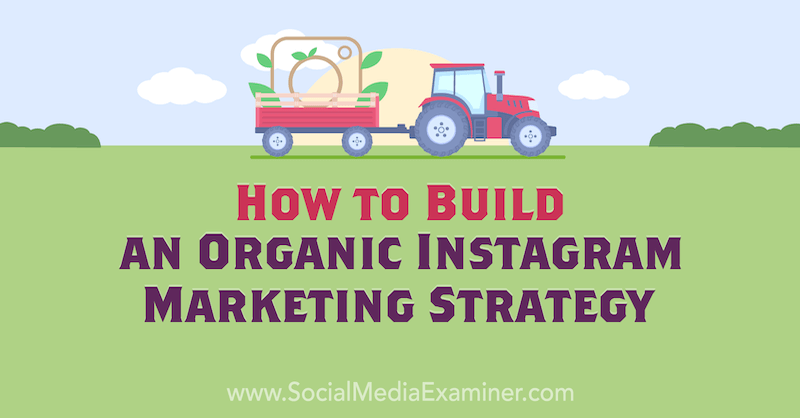
True or false: It’s impossible to sell on Instagram.
Of course, the answer is “false.” You can successfully build your business on Instagram. There are direct-to-consumer (DTC) brands worth millions that started on the social network and still use it as their main sales channel. And they did it with an organic Instagram marketing strategy.
I’ve heard plenty of marketers say that Instagram is fun, or good for customer relations, or an expected part of their brand presence, but it never makes them any money. Well, it doesn’t have to be that way. For 61% of DTC brands, social media is their main channel for customer acquisition.
Below are just a few of the most famous DTC brands that got their start on Instagram. Note that they all feature community, people-power, or inclusion on their profiles.
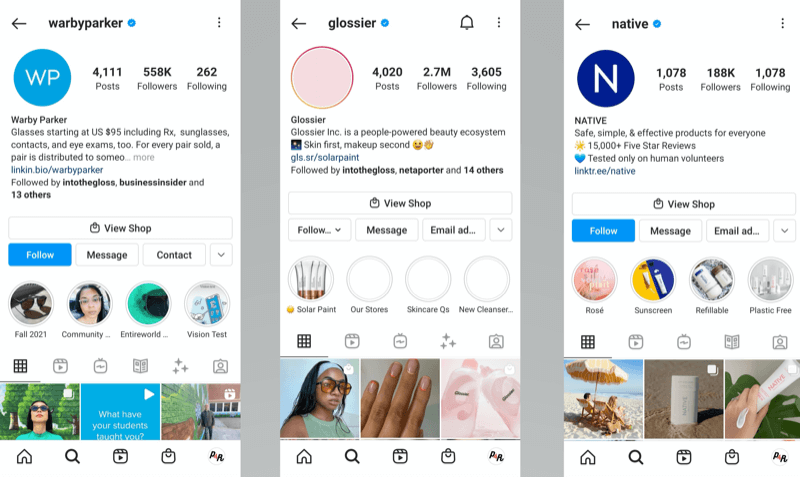
Here’s how you can create an organic Instagram marketing strategy for your business.
Your Instagram profile is nothing without an audience. What’s more, it has to be the right kind of audience. Who do you want to speak to?
Start by defining your audience. You’ll need to think about:
Pro Tip: Some large brands like Adidas create multiple Instagram accounts to cater to different audiences; for example, separating men’s fashion from women’s or running separate accounts for different locations. However, I wouldn’t recommend this for a small business because it can be confusing for users to search through different profiles.
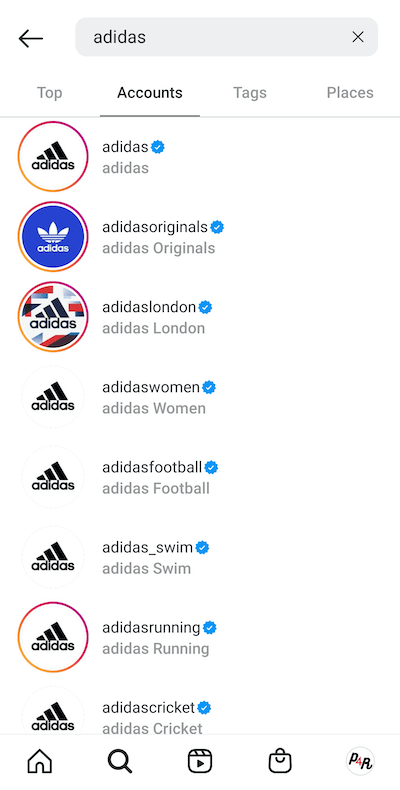
There’s a trap in organic Instagram marketing.
Because you’re not creating ads—which have their own structured process of choosing a goal, writing a CTA, and adding a link—it’s easy to forget your original aim. Suddenly, you’re posting infrequently without any sense of purpose or direction. And the rate of conversions on your Instagram business profile is sinking fast.
The way out of this trap is to have very clear aims for every single post. If you can’t explain in one sentence what job the post does, you shouldn’t publish it.
For example, each of these posts from Rothys has a clear goal: to hire a new colleague, advertise a new product, or start a conversation.
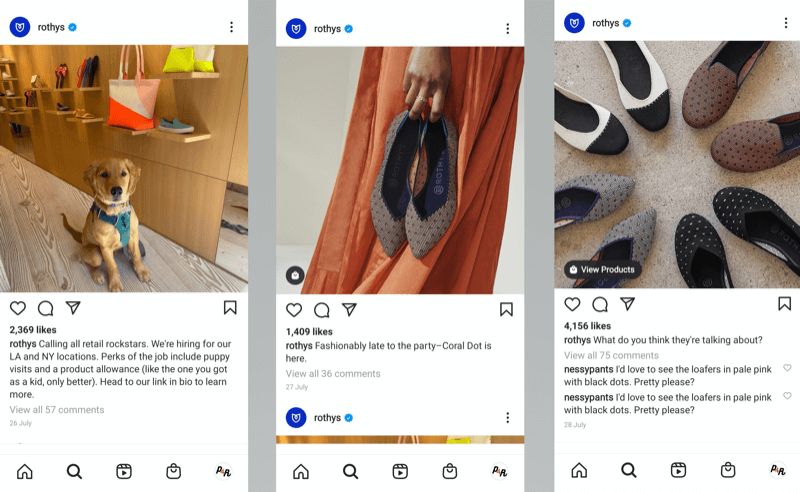
It’s fine to have different posts focused on different goals. You just don’t want any content floating around without a purpose.
Here are some good reasons for posts in your organic Instagram marketing strategy:
The Hims Instagram profile features a lot of memes but they’re all carefully chosen to highlight products, start conversations, or appeal to their target audience.
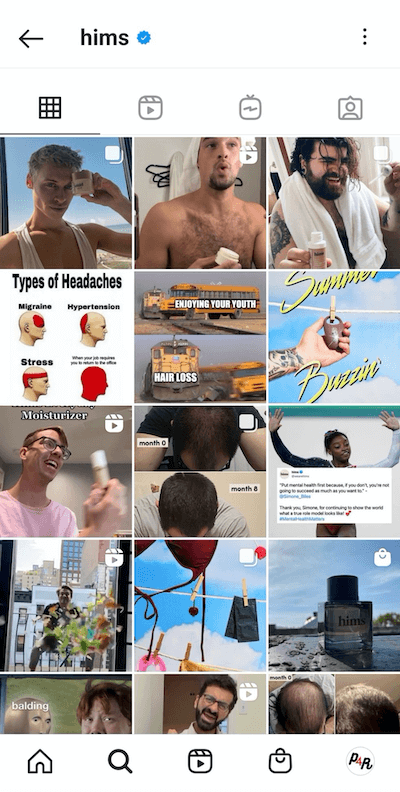
Here are some bad reasons to post:
One way I like to keep track of posts is by writing up a list of SMART goals for the Instagram account. Then under each goal, I make some quick notes:
This list becomes a reference point. You can check back to see the purpose of each new post and get ideas for more content.
Research is an underrated element of organic marketing on Instagram. Over 80 million images are uploaded to the social network each day. That, my friends, is over 80 million data points.
Now of course I’m not suggesting that you review every single post on Instagram. Who has the time? But you should absolutely be doing targeted, continuous research.
As you can see below, Glossier follows a lot of other beauty brands. There’s a reason for that: competitor research.
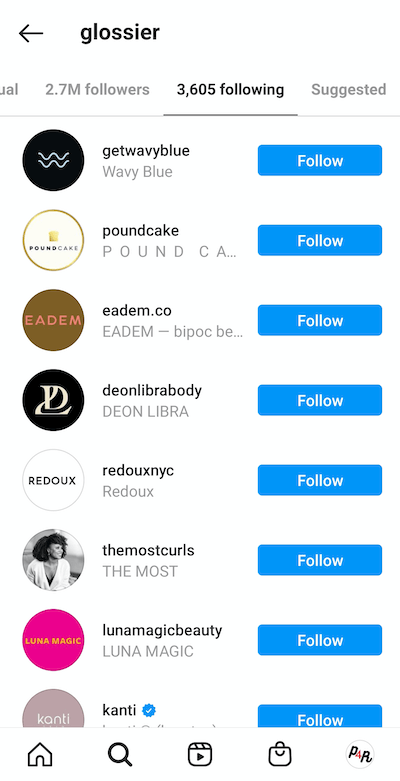
Here are some of the key areas to cover:
This research will generate content ideas and help you appeal to your audience. However, you’ll need to repeat your research regularly so that the information is up to date.
Pro Tip: Try to schedule regular research sessions. This is also a great way to get a new marketing team member up to speed—ask them to update your research findings and they’ll become familiar with your brand aims and audience in the process.
Conversions on Instagram are hard. Let’s not pretend otherwise.
But it’s a lot easier to convert customers on the platform than it used to be. There are more ways than ever to share active, clickable links on Instagram:
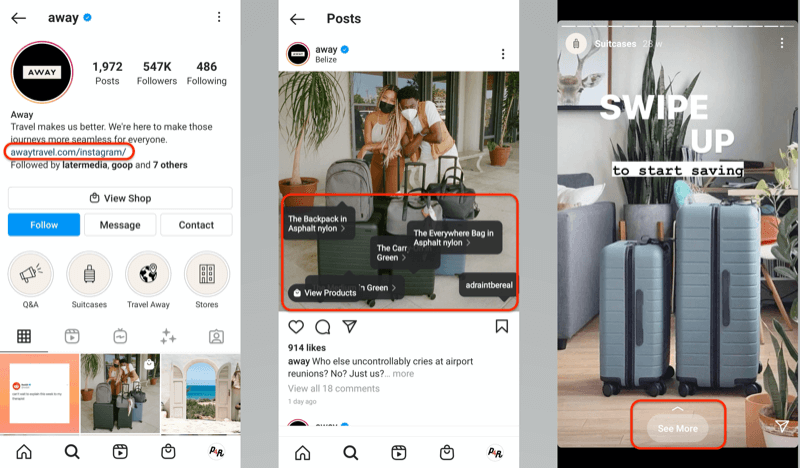
There are also rumors that Instagram plans to roll out story links to more accounts so watch this space.
If you want to get more clicks and conversions, you need to use all of those formats. Make it easy for people to find the links and follow them. Set a regular reminder to check that the links in your bio and shopping tags are working correctly. Always link to a specific page, rather than dropping users on your website home page and expecting them to navigate by themselves.
Most of all, you need to ask for those link clicks. Don’t just drop a link—give your followers a specific call to action (CTA).
ThirdLove never misses an opportunity for a CTA.
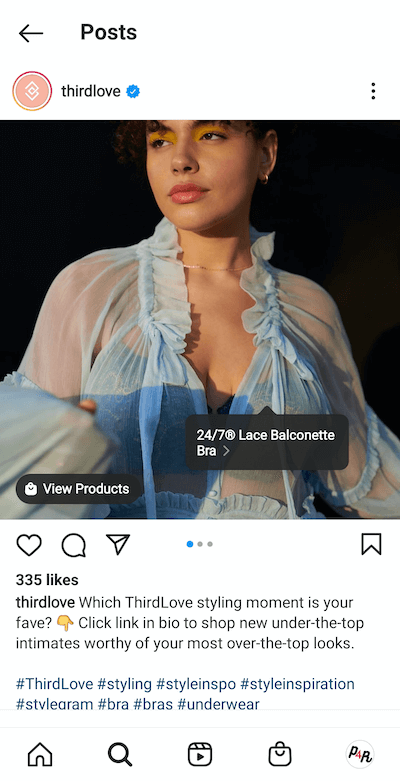
Some brands struggle on Instagram because they don’t commit enough. Others struggle because they try too many things too fast without the resources or skills to support them.
So when you’re planning an organic Instagram marketing strategy, start with a realistic assessment of your situation.
Remember that you can make the most of your resources by focusing on what followers want. A 2018 survey from Sprout Social found that many social media managers insisted on creating content that worked for them, rather than for their followers. Most notably, Instagram users said that they wanted to see discounts and learn more about new products and services. Those are golden opportunities to make a sale and social media managers were missing them.
Say it again for the people in the back: You. Need. A. Style. Guide.
Here are just a few reasons why:
Your style guide should include a summary of what kinds of content you make, how you make content, your goals for organic Instagram marketing, and your process for analyzing and reporting results. It should be updated regularly and shared with everyone on your team.
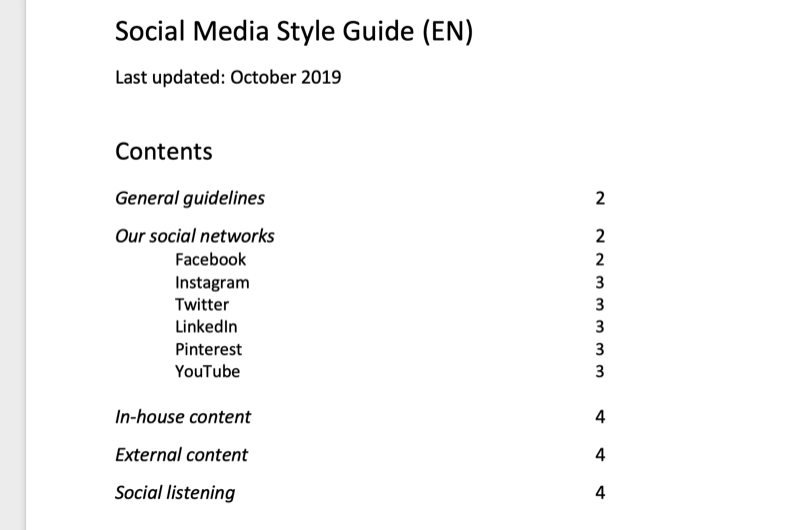
If you don’t yet have a style guide for Instagram—or you need a refresher—this article walks you through how to create a social media marketing style guide.
Instagram is a visual medium. It’s all about the photos and videos so you don’t need to worry about copywriting… right?
Wrong. The words you use are a key part of your Instagram marketing strategy.
Text and captions provide vital context for the photos and videos you post. The copy in your bio explains what you do and welcomes new followers. And with the right CTAs, you’ll see more clicks, saves, shares, and sales.
Instagram gives you a lot of space to write Instagram post captions. You have 2,200 characters to work with, which works out to just over 300 words. That’s almost a short blog post.
DTC toothbrush brand Quip uses long captions to describe its charity efforts and support important causes.
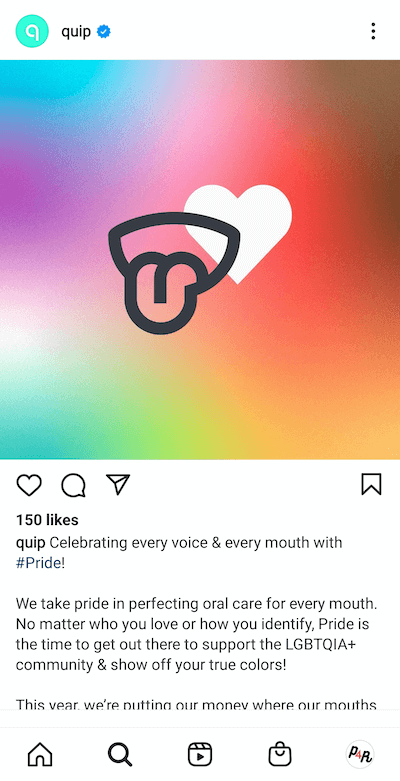
Not every post will need a long, heartfelt caption but if you just caption your posts with a couple of emojis and a hashtag, you’re leaving money on the table.
Use the writing opportunities that Instagram gives you to explain, persuade, describe, and convert. If this is something you struggle with, it may even be worth hiring a copywriter to get you started.
There are three big reasons to include user-generated content (UGC) in your organic Instagram marketing strategy:
Collecting UGC on Instagram is as simple as setting up a branded hashtag or checking through your mentions regularly. If you want to collect a lot of content quickly, you could try running an Instagram photo competition.
For instance, Warby Parker runs fun competitions to collect UGC and give away popular products.

UGC doesn’t just consist of feed posts, though. You can also share and interact with comments, DMs, and stories. Make sure you have the user’s permission to use their words—then share, share, share.
You can also bring UGC on board by running account takeovers and interviews. These are really fun ways to outsource your content and turn it into an event.
We’ve already discussed how every piece of content on your Instagram profile should serve a purpose. But that doesn’t mean that every post should serve the same purpose.
Build variety into your Instagram strategy. Try out different formats. Celebrate holidays and annual events. You could even try changing color palettes with the seasons.
Chubbies does a great job of creating seasonal content with enticing offers.
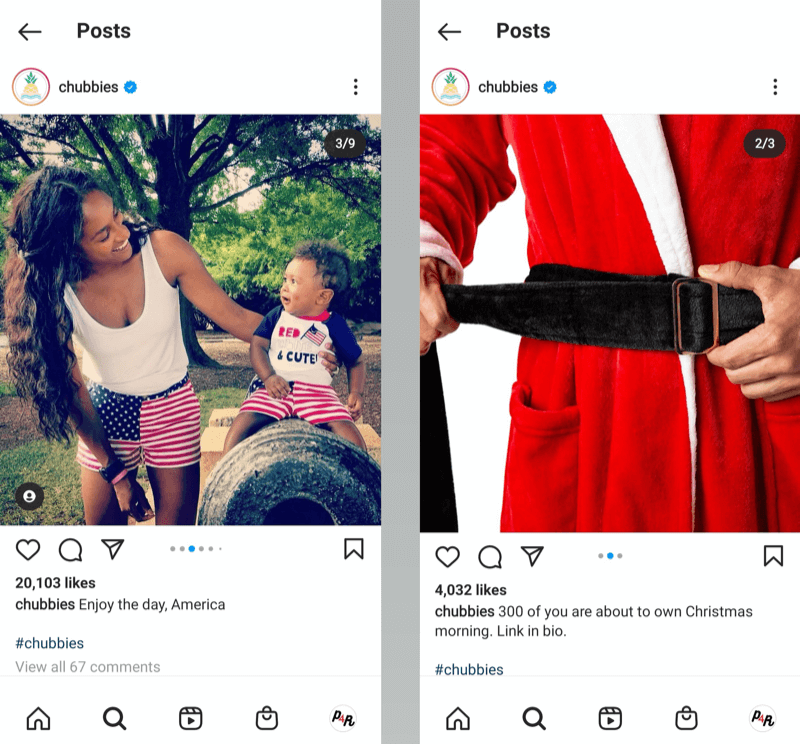
Varying your content has two benefits: It keeps followers interested and it shows that you’re not just focused on sales. There should always be space in your content calendar to have fun with your followers or raise awareness of a cause that’s important to you.
If you find it difficult to vary your content, then try leaning into your calendar and scheduling. It’s much easier to create diverse, engaging content when you have regular reminders. And if your followers know that (for example) you share a puzzle every Saturday, they’ll start to watch for your posts.
An organic Instagram marketing strategy doesn’t just mean broadcasting to the world. It has to be interactive. It has to benefit both your business and your followers.
Set clear guidelines for customer engagement and include them in your social media style guide or policies. You’ll need to include details such as:
Interaction is what turns your Instagram profile into a community. Followers will pick up on the fact that you’re present, interested, and engaged. Think of it as laying the groundwork for customer loyalty.
For instance, StitchFix responds to its followers with helpful instructions and suggestions.
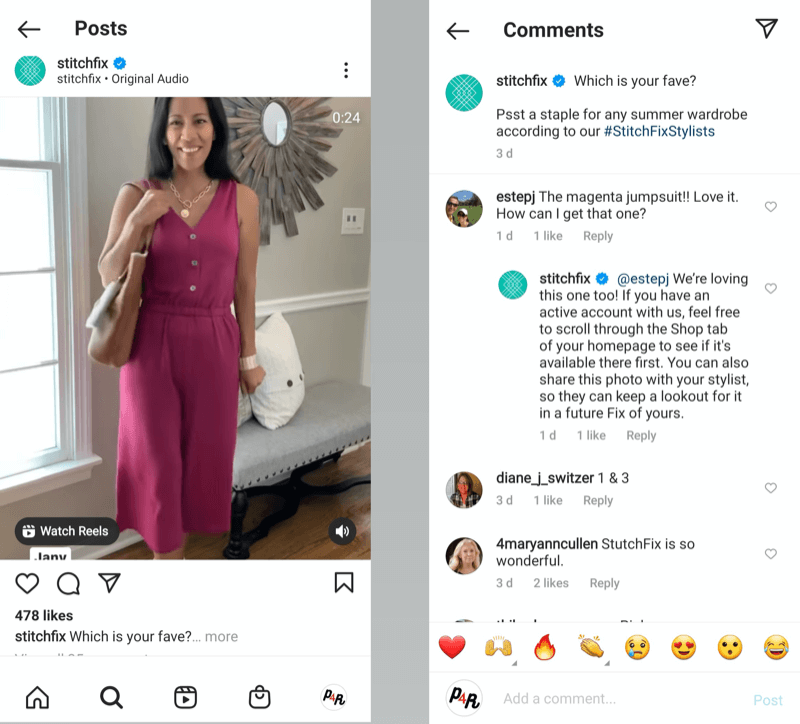
Instagram Insights are pretty thorough. You can also access insights and sometimes see them presented in more detail via social media management apps.
But the key question about insights is whether you actually act on them.
Remember when we talked about setting SMART goals for all of your content on Instagram? Well, insights and analytics are how you track your progress toward those goals. You’ll need to look into your growth, reach, engagement, and conversion rates.
A word of warning here: Some social media managers make the mistake of overriding the insights. I’ve seen it happen many times. “Oh yes, that post did get lots more engagement… but our followers don’t like that kind of content.”
Forget your assumptions about what your followers like or how they behave. What are the numbers actually saying? Be honest with yourself.
DTC personal care brand Billie shares a lot of inspirational and factual content but one of its most popular recent posts is this video of a hedgehog in a pool.
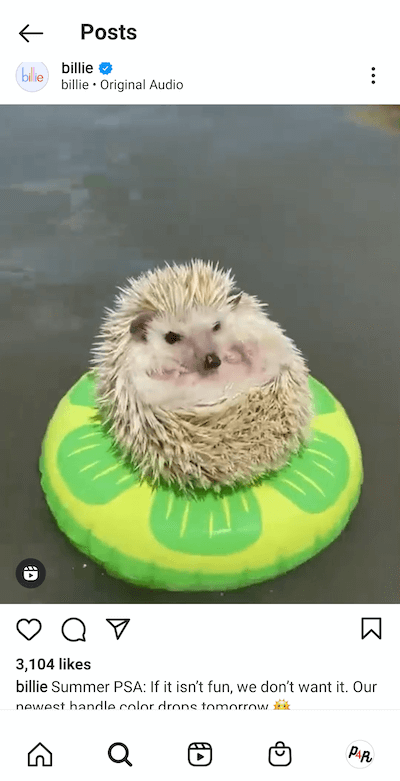
You can add to insights by considering customer feedback, as well. The greatest strength of DTC brands is that they speak directly to their customers. This kind of qualitative feedback should support the raw numbers in your analytics.
If there’s one thing I want you to learn from this article, it’s to never stop improving.
Your organic Instagram marketing strategy is never finished. There’ll always be new post formats to test, trends to try, followers to understand, comments to respond to, and stories to tell.
The word organic means something that grows naturally. The key word there is “grows.” If your Instagram strategy doesn’t change over time, then it’s already dead. You want to keep your presence on the social network fresh, green, and full of new ideas.



Simply provide your email and we will contact you to get your free website.